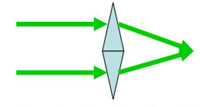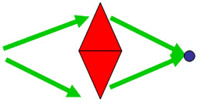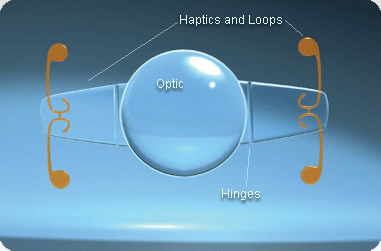Monofocal
How do monofocal lenses work?
When light enters a monofocal lens, it is bent to a focus point. As the power of the lens becomes stronger, its ability to bend light more sharply is increased. Since the lens is monofocal, the light can only be bent to one focus point at a time. With monofocal IOLs, the light is bent by the lens so that it will form a focus point on the retina of the eye. A surgeon can choose an IOL that focuses light best coming from distant objects, or a stronger powered IOL that focuses light better from near objects. However, light cannot be focused from both distant and near objects at the same time with a monofocal lens. Most patients choosing a monofocal lens choose to have good distance focus, and use reading glasses to help with near vision tasks.
 |
 |
Monofocal lens bending light |
A more powerful monofocal lens |

What are the Pros and Cons of Monofocal lenses?
There are several positive features of monofocal intraocular lenses (IOLs). First, the latest generation of monofocal IOLs, which employ aspheric lens technology, offer the sharpest image of any available IOL. Examples of aspheric IOLs are the Tecnis™ IOL, the AcrySoft IQ™ IOL and the Sofport™ IOL.
Due to their aspheric design, these lenses provide excellent contrast sensitivity and an extremely high quality of vision in a variety of lighting conditions. Individuals who require excellent distance vision, such as golfers, or those who frequently drive at night, may be well suited with an aspheric monocular IOL. People who have certain eye diseases, such as macular degeneration or glaucoma, may also benefit from an aspheric monocular IOL. For these individuals, the compromised state of the retina is assisted by the aspheric lens to form the sharpest image possible on the retina. Lastly, monofocal lenses are typically covered by insurance and Medicare, so this lens requires no additional out-of-pocket payment from a person undergoing eye surgery.
One disadvantage is that only one zone of clear vision can be chosen with a monofocal lens. Most people choose to have their monofocal lens set for distance vision and use reading glasses for near tasks. Alternatively, a monofocal lens can be set for near vision, but glasses or contact lenses are then required to see objects clearly at a distance. A blending of these two approaches is also available for individuals undergoing cataract surgery or natural lens replacement in both eyes. In this approach, called monovision, the monofocal IOL placed in one eye can be set for distance and the IOL placed in the other eye targeted for near. While 85% of people can adapt to monovision correction, a small percentage of people, however, may feel off-balance with this approach.

